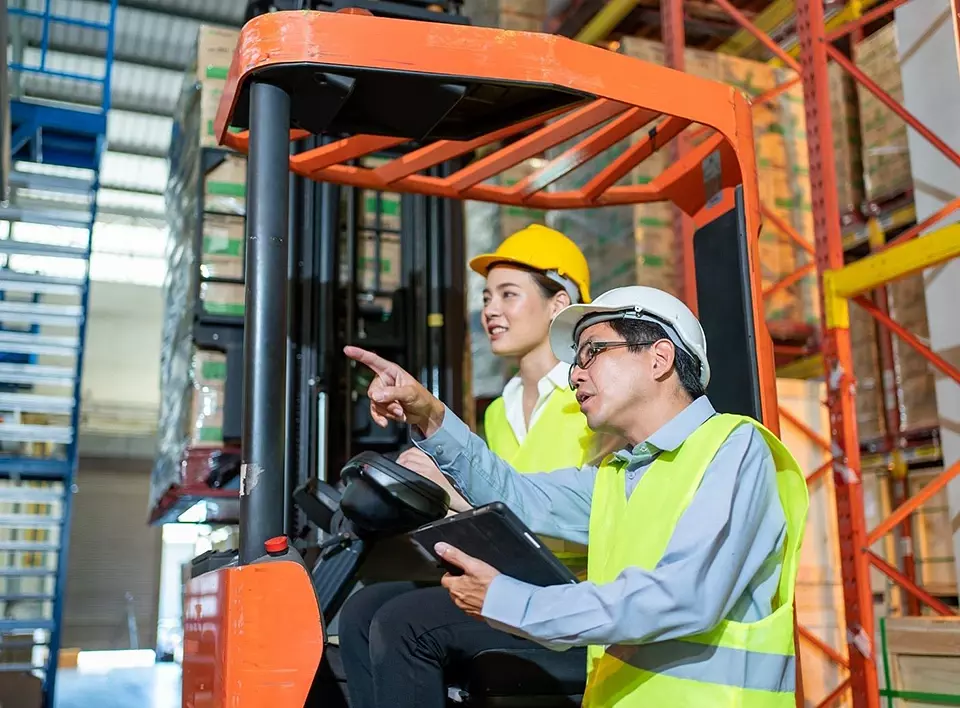FORKLIFT SAFETY TRAINING GUIDE
 Learning how to safely operate a forklift is integral to ensuring the lift runs smoothly and without risk, follow our forklift safety training guide to avoid such risks. A forklift should not be a hazard to its surroundings or to the driver, and this is ensured through the employment of a skilled and trained operator. Understanding the particular parts and functions of a certain type of forklift is important, but time consuming. The forklift operator must become completely aware of the surroundings in which he will be operating his forklift in order to understand the hazards and difficulties he may face. Using a checklist before operating a forklift is the best way to ensure safety and prevent injury or damage.
Learning how to safely operate a forklift is integral to ensuring the lift runs smoothly and without risk, follow our forklift safety training guide to avoid such risks. A forklift should not be a hazard to its surroundings or to the driver, and this is ensured through the employment of a skilled and trained operator. Understanding the particular parts and functions of a certain type of forklift is important, but time consuming. The forklift operator must become completely aware of the surroundings in which he will be operating his forklift in order to understand the hazards and difficulties he may face. Using a checklist before operating a forklift is the best way to ensure safety and prevent injury or damage.
FORKLIFT CHECK UPS & INSPECTIONS
Regular check-ups on parts that are not mentioned in the safety checklist are significant for keeping the operation of a forklift safe. A forklift should pass an operational inspection before using it in any setting with potential risk. This will ensure that it does not come across any nasty surprises during regular operation, such as mechanical breakdown or overheating.
PROPERLY TRAINED LIFT OPERATORS
When it comes to actually operating the forklift on a regular basis, the employment of a fully trained and certified operator is key. Load handling should be understood and maneuvered with skill, as off-center loads and overloading are the two main hazards in load composition. Knowing the capacity of a particular forklift is essential in order to not make the mistake of overloading. An aptitude for stacking and unstacking in an orderly and stable fashion is also crucial, and understanding the tilting of the mast and fork should be mastered for transporting loads. A forklift should never travel with a load that is forward tilting, because this increases the load distance, making it much less stable than when it is tilted back on the mast.
BE AWARE OF WORKPLACE HAZARDS
To operate a forklift as safely as possible in a particular workplace, the hazards and complications of certain areas should be noted and understood by the operator. These hazards can all be dealt with, so long as the operator is constantly mindful of them. The complications of these risks fall under the following main topics:
Elevators – Always make sure the elevator to be used is capable of carrying the combined weight of the machinery, load and operator.
Enclosed and Hazardous Areas – Indoor air quality and carbon monoxide poisoning are notable hazards.
Loading Docks – Fatal accidents can occur from falls in loading docks.
Narrow Aisles – Although narrow aisles allow for more storage, they require very skilled maneuvering.
Pedestrian Traffic – Falling loads or collisions with forklifts can cause fatal injuries to pedestrians or bystanders.
Physical Conditions – Ground surfaces should be sturdy enough to hold a forklift and free of slippery substances.
Ramps and Grades – There are different ramp and incline rules that operators should also understand.
When owning and operating a forklift there are an array of factors you need to continue to think about and stay up to date on to ensure the utmost caution is taken at your worksite. Staying current on forklift safety guidelines and training can help you maintain a safe work space and improve your overall productivity and efficiency. As always reach out to the forklift experts at National Forklift Exchange if you have any additional safety questions!

